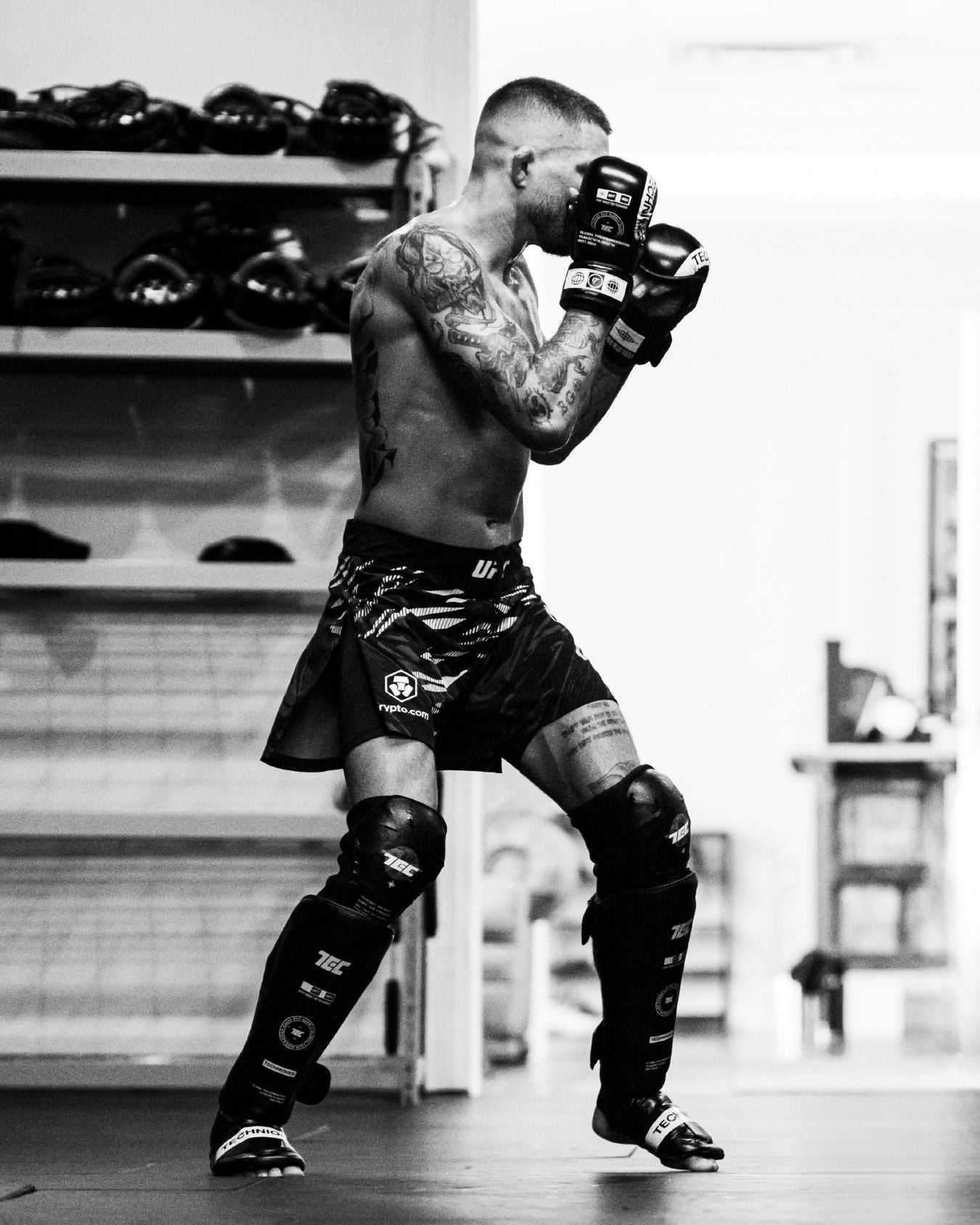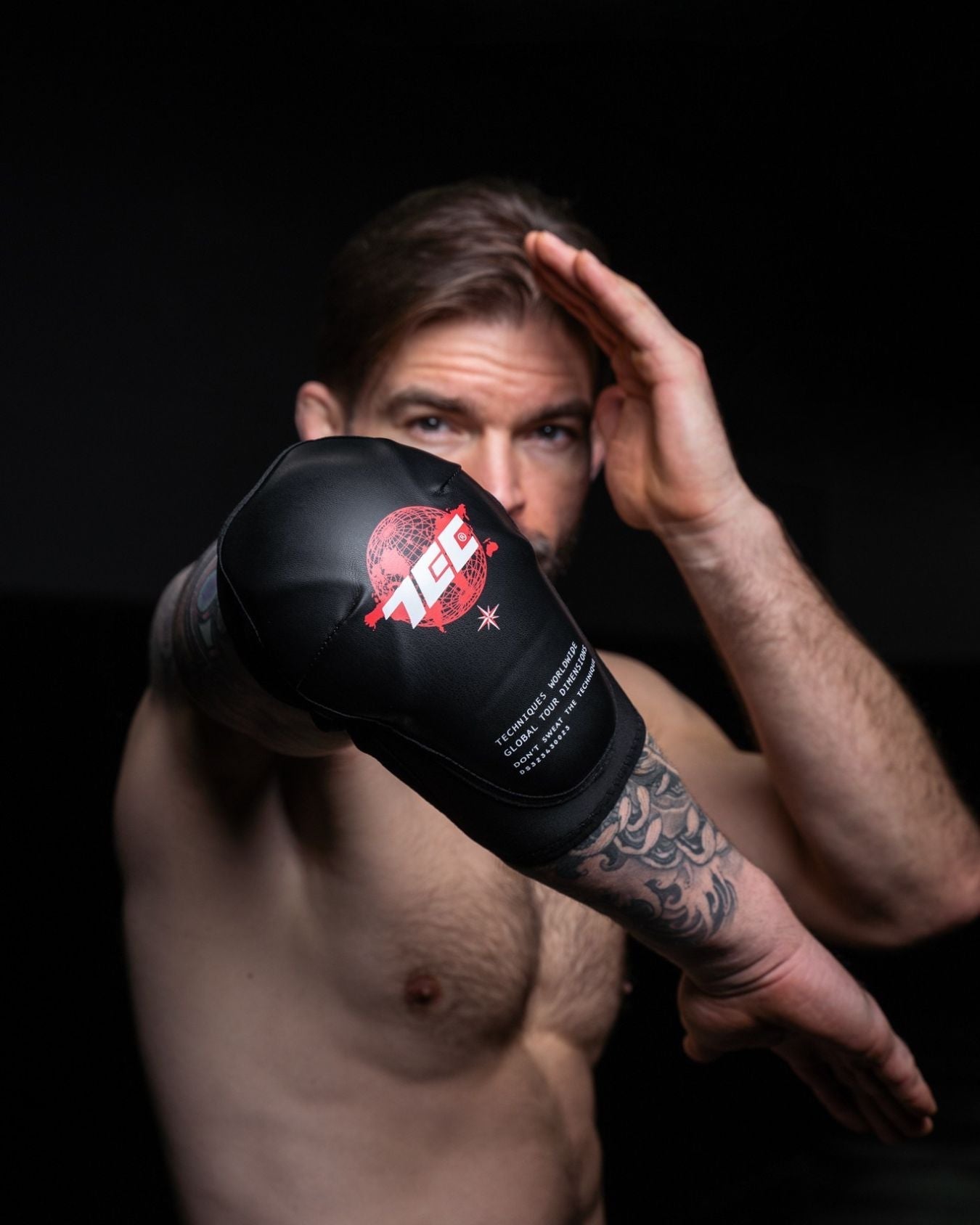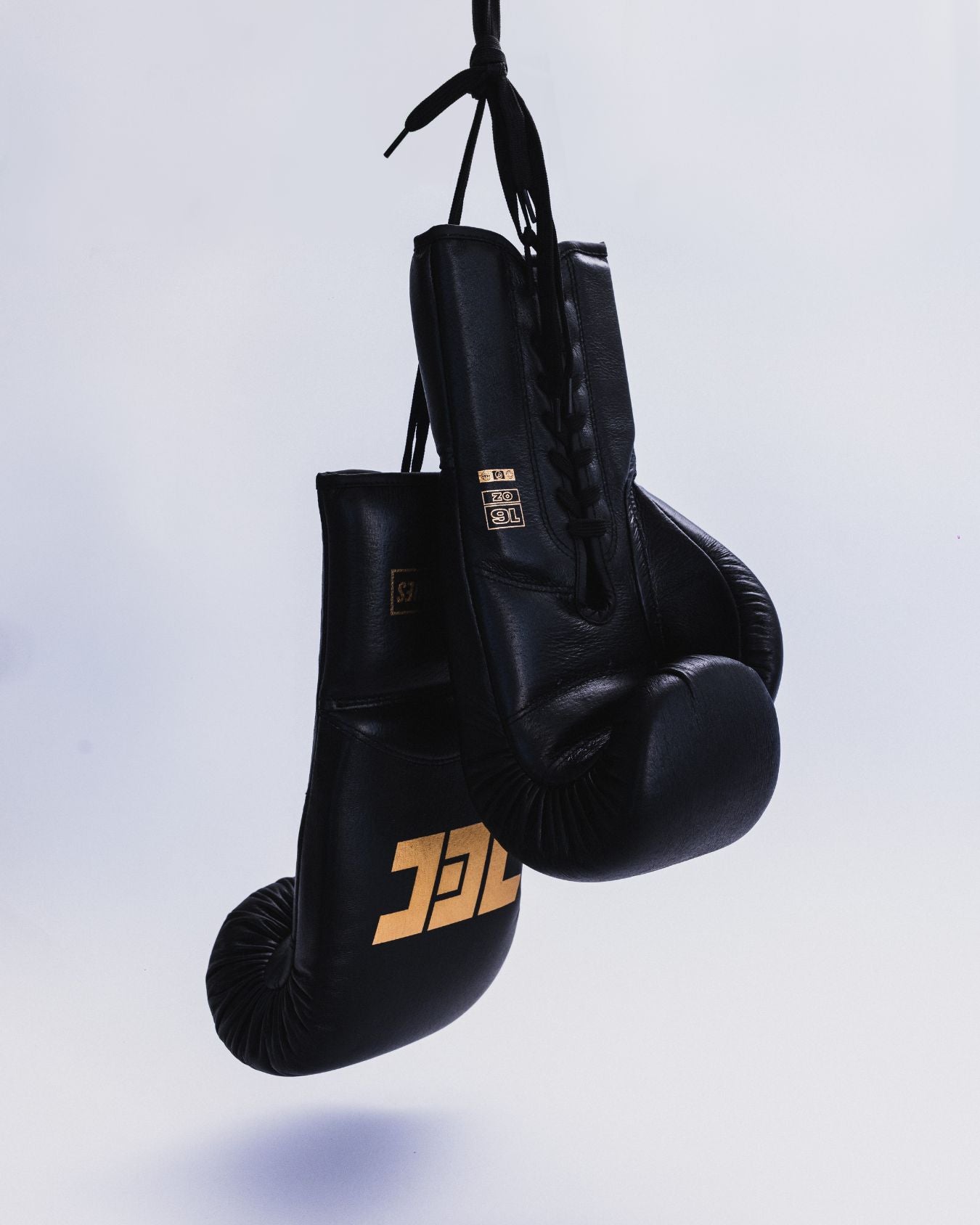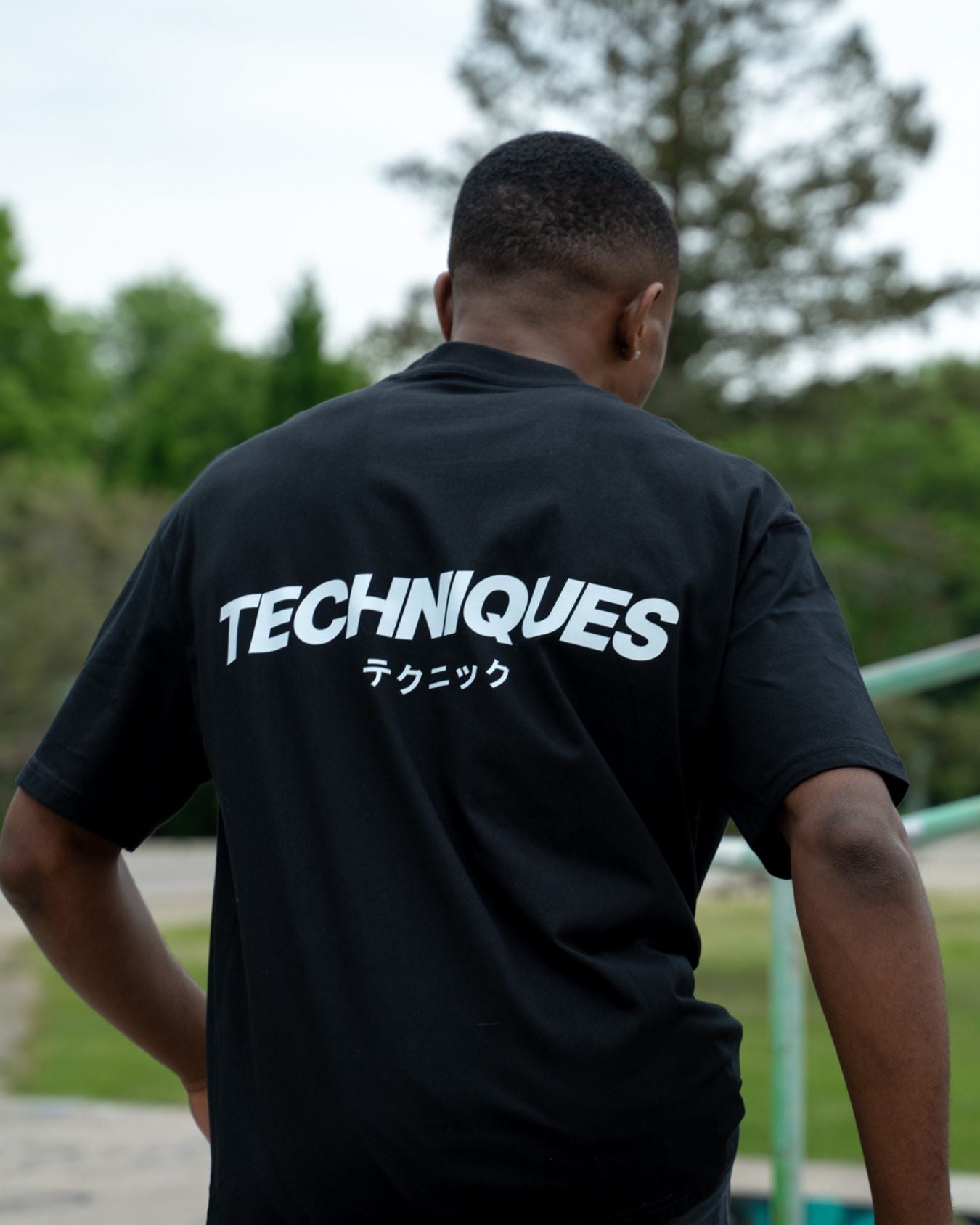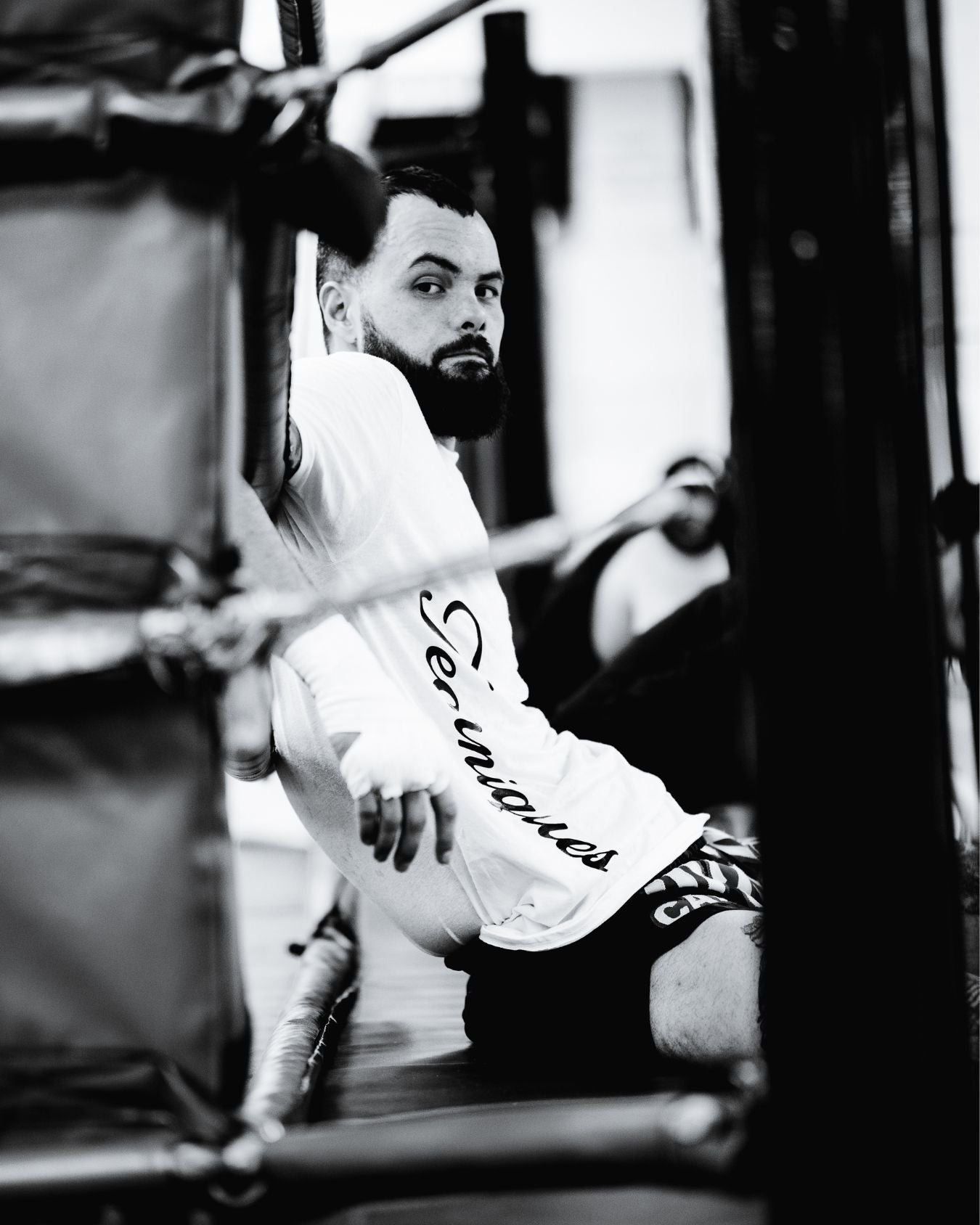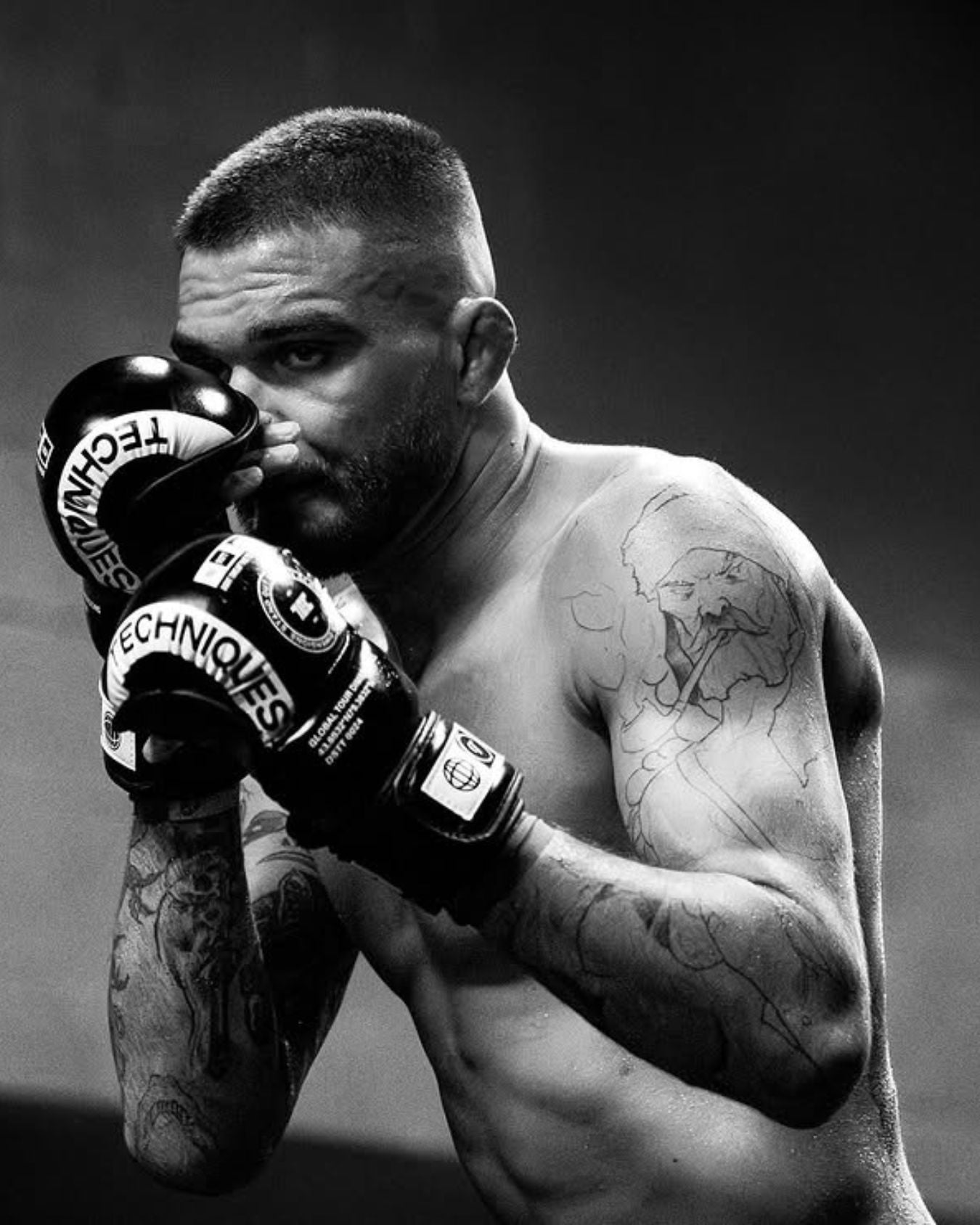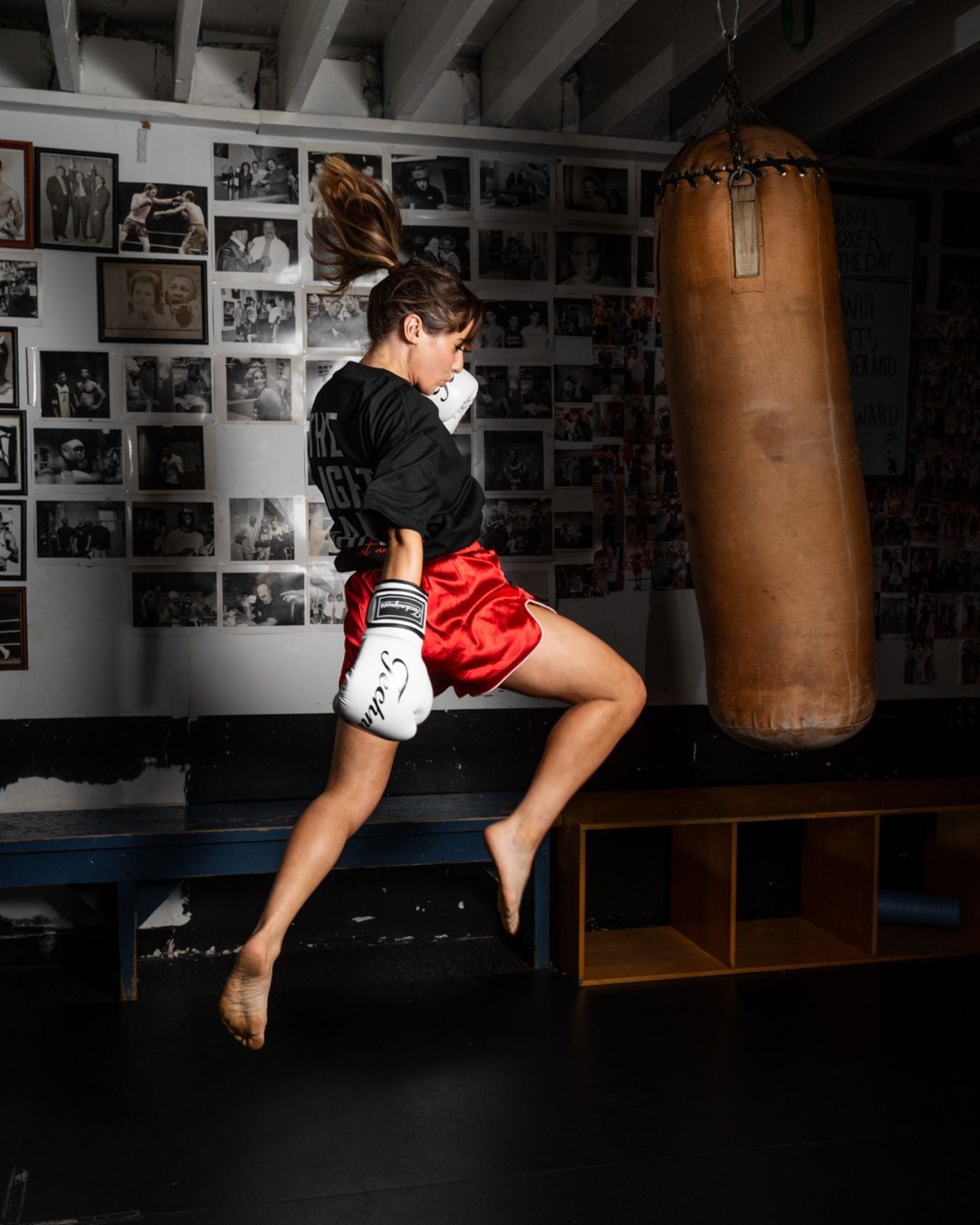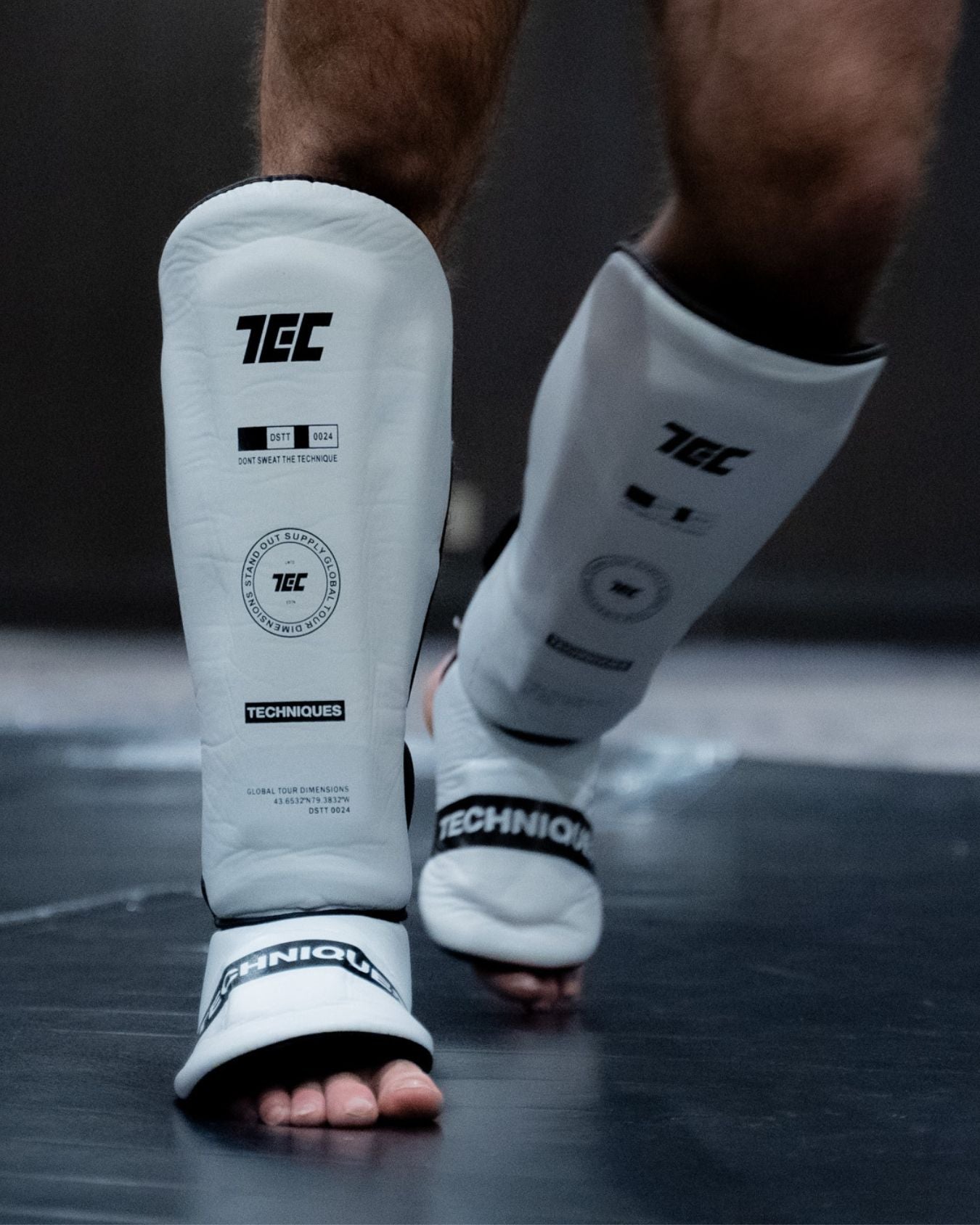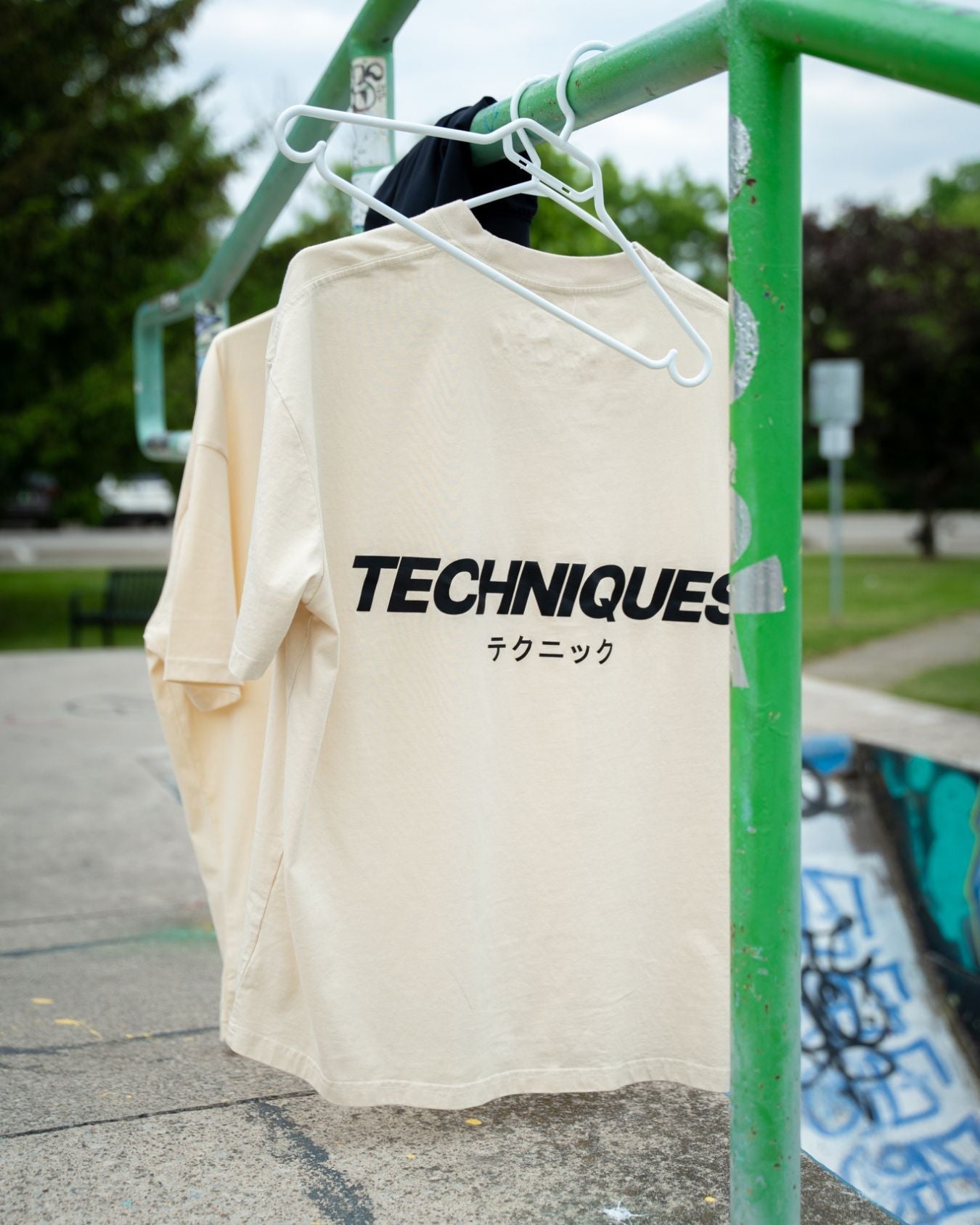The Ultimate Guide to Striking

Martial arts have been around for thousands of years, with different philosophies and ideas for each art form, each believing that theirs was the best for unarmed combat. Rule sets made them evolve over the years, as not having to worry about being punched to the face or being kicked to the leg made certain stances or ideas applicable but inapplicable once these rule sets changed.
The argument on which art was best continued until Bruce Lee introduced a wild idea for the time. Everyone is not made equal, what works for me and my body type may not work for you. If a technique from one martial art works for you, then you should add it to your arsenal, no matter if you are a practitioner of that specific martial art. We should be martial arts practitioners and not practitioners of a specific martial art.

That seems like common sense today, where fighters have the platform of MMA to see what really works and what does not. But at the time, it was revolutionary.
Our next large evolution came with the UFC, as they asked a new question. With no rules, which martial art reigns supreme? Royce Gracie showed that Brazilian Jiu Jitsu was essential, and it seemed like BJJ was all you needed to know.

But what if someone was an Olympic wrestler and could control the Jiu Jitsu fighter, damaging them from mount? What if a striker learned wrestling defence to keep the fight standing and damages you from their preferred striking distance. What we instead came to find out, is that they created a whole new sport.
Now the main question has changed, no longer which martial ART is the best, but which martial ARTIST uses their techniques best against another martial artists.
The illusion of one art form being the best is gone. What we know is there are three different main ranges, striking (stand up fighting), wrestling (defensive or offensive), and grappling (ground fighting). What you do within these walls and ranges is up to you.
Let's take a deep dive on one of these ranges, striking range, while taking into account a ring or an octagon. Feel free to click on the links to bring you to each section.
Now also available in 3 part video format, part 1 - Stance, Ring & Octagon Control:
Part 2 - Feints & Angles:
Part 3 -
Stance
The first place to start in any type of martial art is the stance. As your stance should place you in a position to move in any direction dynamically and quickly, while giving you a strong base without losing balance.
In arts like Wing Chung, practitioners position their feet in a more square stance, opening their body to their opponent. This allows them to use their hands to negate any weapons but gives their opponent's a very large target to hit while also not supporting a strong base.

In Karate, practitioners have a fully bladed stance where they are almost fully side on to their opponent's. This stance was developed because karate tournaments were often above the waist and use point karate rules, meaning one can only strike their opponent above the waist and once you touch, a point is scored, the action is halted and we reset the fighters.
Therefore their stance allows for more explosive movements of the feet but opens them up to the problem of lead leg kicks and sidekicks in other rule sets because of the awkward positioning of their lead foot. There are however some amazing fighters who have made this work for them.

In Muay Thai, the stance provides for a strong base against the leg kick attack by having their lead foot facing forward and tightly placed beside their back foot which faces sideways.

This lead foot is close to the back foot so that it can check leg kicks from their opponent, as weight can be easily shifted onto the back foot to stand on one leg. Developed in part also because of the rules of Muay Thai, no takedowns, leg kicks score most and impact of strikes having a large part of scoring. Muay Thai fighters also seem to get caught in the mindset of standing in front of each other and scoring back and forth, losing the value of movement and footwork that you saw in the golden age of Muay Thai, with fighters like Samart Payakaroon and Sagat Petchyindee. Samart and Sagat competed under boxing and Muay Thai rulesets so they had the benefit of understanding head movement, and angles.

Sagat from the popular game Street Fighter was based off of the Muay Thai fighter Sagat Petchyindee, and many of the moves in the video game were actually based off of moves Petchyindee used in real life.
When looking at modern rulesets of Muay Thai, Kickboxing and MMA, it is best to ensure that your stance has a strong base, with footwork that can move quickly away from and into strikes.
Because of this your feet should be shoulder width apart, with your lead foot pointed straight forward and your rear foot pointed out on approximately a 60° angle. This is done so that you have the ability to check kicks and not be thrown off balance. While your wide, bladed stance makes you small and allows for dynamic, quick movements in either direction.

The dotted line between your two feet is called your centre line. This line should not be crossed incorrectly without fully understanding why and how.
Footwork
A massively overlooked part of fighting is footwork. It is easy to learn, but takes hours and hours of practice, so no one wants to do it and they struggle because of it. You would be very surprised at the amount of high level professional fighters who's footwork is not up to standard.
The foot that moves first should always be the closest one to the direction you are moving. This means that if you are moving right, your right foot should move first.

This is done so that you can easily throw a punch while moving. If your opponent gets too close, you can plant on your rear foot and throw any weapon of choice.
From here your lead foot can now also cross the centre line and position itself in your proper stance, in turn creating a new centre line.

If you had moved your front foot over the centre line first, this would place you in a compromised position. As your balance is off and you are not in a position to strike if need be.

This incorrect type of movement for fighting is how we walk every day and therefore feels natural. So simple movements left, right, forwards and backwards should be done before every workout, until it is ingrained into muscle memory.
Using that same concept we mentioned our same side foot moves first, so the left foot moves first when moving left. Our right foot then follows again, creating a new centre line to stand on strongly.

When moving forwards and backwards, the same concepts apply. If I move forward, my lead foot moves first. If you are an orthodox fighter, this means your left foot, and if you are a southpaw fighter this means your right foot.

We move lead foot first because if you need to attack or are being attacked mid-stride, you have a base underneath you to throw any of your weapons. Our rear foot then moves forward after the lead foot. Again placing you in your original stance and creating a new centre line.

This type of walking for martial arts goes against our natural inclination. If we walk down the street, we would want to take the step that is most efficient in moving us forward, which would be back foot first. So lets take a look at what happens when you step back foot first while attempting to stay in our stance.

We end up in a strange stance that provides us no base, balance or ability to be dangerous while moving. This is not a position where you can easily attack or defend, and in the sport of MMA you could be shot in on and taken down much easier.
Moving backwards, same concepts apply as the closest foot moves first, this time our back foot, which is then followed by the lead foot.

Correct movements moving backwards are actually the most vital because great strikers use distance management to evade punches and kicks, then come in hard with their own to counter.
A great striker understands that if they take a small step back with their rear foot, in turn pulling their head back by a few inches, that is all they need for their opponent's punch to miss.

Once this punch is evaded, you can use your rear leg as a spring to bounce off of to propel you forward into a cross. This creates the basis for a pull cross counter, you can see fighters like Conor McGregor, Israel Adesanya, Darren Till, Sean O'Malley and Floyd Mayweather using this type of evasion and attack patterns in every single one of their fights.
Take another look at the video above and notice that Conor also doesn't exit in a straight line. He takes two steps back, hits a left cross, then angles off the centre line. This angle is very important for defensive tactics. If you only step back straight, then you can be pushed towards the fence and bullied. If you angle off after one or two steps then you cannot be chased.


If we moved back with the lead foot first, this counter would not be possible. There are many examples of fighters moving backwards with the lead foot first and being hit and finished. One would be Cody Garbrandt vs. TJ Dillashaw 1, Cody moves back lead foot first, at the same time TJ gains distance with a switch left head kick.

This kick barely lands as it grazes with the toes, but because Cody doesn't have a strong base under him he is in no position to absorb the kick and it does much more damage than it would have if he was in a strong stance. TJ capitalizes on this moment and finishes Cody later in the round after dazing him with this kick.
A massive point people miss in fighting is that footwork and feints are defence. Too many coaches and fighters think of defence as just putting a hand up to block, or slipping and rolling punches. Your first level of defence should always be your footwork, as you can't be hit if you are not there to be hit. The second level is feints, as an opponent will have second thoughts about throwing attacks if they are in perceived danger themselves. Rolls, pulls and slips are our third level, once attacks are actually thrown. Last resort should be to block a punch, when all other options are not available, especially in MMA where the gloves are very small and punches can easily slip through the guard.
Being dangerous is the most important aspect of fighting. You should understand how to make punches miss and hit back off those misses, whether through footwork, feints, slips, rolls, blocks or pulls. Consistently add these together and you will be dangerous to fight, while being appropriately perceived as dangerous by your opponent. If you stand there with both hands covering your face and do not move, you are not a fighter, you are a punching bag.
Ring Control
Now that we've learned how to walk properly for martial arts, let's learn how to use it. There are typically two ways to use footwork, as the bull or the matador.
The bull should work to pressure the opponent into corners, while the matador should use angles and evasion to never allow themselves to be trapped and set up their strikes from odd angles.
Starting with the bull, if done correctly you should always be controlling the centre of the ring, pushing the other fighter to the outside of your area.

The green is the area you want to dominate by pushing your opponent up against the ropes and into the red area through feints and footwork.
In the ring, since it is a square, we keep our opponent trapped by using two main angles. When the opponent is up against the middle of the ropes, we track their movements step for step on a 90° angle, keeping our centre line directly in line with their centre line.

If you stand at anything but a 90° angle you give your opponent the opening to move into the middle of the ring, which again, is your space to dominate.
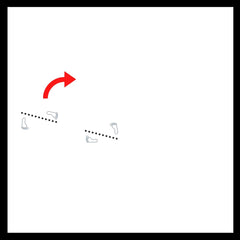
Standing at approximately a 80° angle above, it gives your opponent the opening to move into the middle of the ring.
Staying on this 90° angle will cause pressure, in turn making our opponent want to move and forcing them into corners.

Here we stay on a 45° angle, where it allows no room to escape.
If we change that to say a 30° angle, then it would allow for space to exit and escape the corner and the trap we just layed.

In the above case, you would again be giving up the inside space of the ring you are looking to dominate.
A great example of the use of the bull concept vs. a matador is when Joseph Valtellini fought Raymond Daniels. Raymond is a Karate stylist who thrives in open space where he can land his extremely flashy and devastating spinning kicks. For example:

And..

And..

These are devastating moves and can end fights fast, however fighters like this need space to create. They do not do well with pressure and their preferred range is long distance kicking range. Joseph knows this, and proceeds to not give Raymond any space at all. He uses his 90° and 45° angles to cut him off the whole fight, forcing Raymond into corners and slamming in low kicks.

This pressure is applied constantly and it later pays off, as he scores a knockout using bull principles as well as a low and high kick set up. Having damaged Raymond's legs the whole fight, he knows this is all his opponent is thinking about. Forcing his opponent into a corner he instead throws a head kick, scoring the knockout blow.

Fighting is a game of chess and inches, if you can take away the one thing your opponent needs to be successful you can often take away their full game, causing them to look amateurish.
In Thailand they often say punch the kicker and kick the puncher. With ring control the answer is often to play the matador against the bull and the bull against the matador. Neither method is more 'right' than the other, but the fighter who can better implement their strategy will come out victorious.
Octagon Control
As the bull in an octagon, we use the same concepts of controlling the centre of the space. The green again represents your area and should be controlled by pushing your opponent up against the fence and into the red area. The green area is actually displayed with a black line on the canvas of a UFC octagon.

An example of someone who did this beautifully was Raphael Dos Anjos vs. Anthony Pettis. Raphael pushed Anthony up against the fence for 5 full rounds, knowing that Anthony does not fight as well against the fence as he does in open space where he can create. He simply did not allow Anthony to have any open space.

The same concepts of control applies from the ring to the octagon, but the angles change slightly as you do not have the same type of corners to trap someone in. The 90° angle at the middle of the fence is still applicable.

At the centre fence area we can push forward, allowing our opponent to move side to side but not forwards, backwards or angular.
If we stood at anything but a 90° angle, our opponent would be able to exit and in turn take the centre of the octagon.

As we move towards the corner of the Octagon, all that is really happening is we are moving in a circle, always keeping our place in the octagon in mind. So where the octagon fences meet, we want to circle around with our opponent, for instance staying on approximately a 68° angle, again trapping our opponent with only the option of moving left and right.

The most important part of this concept is to not chase our opponent but instead have the forward thinking ability to trap someone, much like you would trap a mouse.
Darren Till for example when he fought Donald Cerrone did a beautiful job of controlling the octagon and applying constant pressure. In the clip below after a brief scramble they break from each other's grips. At this point Darren has a bad angle of the octagon, where neither he or the opponent has an advantage. Instead of moving straight linearly towards Donald, he re-establishes the centre of the octagon by doing a few side steps before moving forward again where he has an advantageous position. This is fight IQ, and its brilliance is often missed.

The pressure ends up being too much and Donald is eventually finished. Notice below after the left cross hurts him, as the camera angle is changing, Darren again resets to the centre of the octagon before attacking, just to ensure he has fully trapped his opponent.

Not understanding where you are located within a Ring or Octagon and why you are located there can be a massive flaw in any fighters game. Even if you do understand and you don't have very basic footwork principles ingrained into your muscle memory, you will not be able to capitalize on this understanding. This can quite literally be the difference between finishing a fight and not finishing a fight. For example if Darren had hurt Cowboy and did not cut the cage off properly, this would give Donald room to escape and more time to recover, possibly not giving him the opening to finish the fight.
Feints
To break an opponent down and push them back to where we want them to be takes more than just good footwork. You have to be perceived as dangerous by being a threat. We do this by not only throwing different attacks at our opponent, but by faking attacks and causing them to freeze.
We call these movements that create reactions or freezing, feints and they are designed to look exactly like the beginning of an attack. The most common feint is the jab feint, as your jab is consistently used as a set up for incoming attacks.
As you land a jab, your lead foot steps forward hard to gain distance and add strength to the punch. This small step is all TJ has to do to get a reaction out of Cody below.

In this way you can control and push back your opponent onto the fence or just display the danger alarm that if you come close, I will hurt you.
Sean O'Malley recently knocked out Eddie Wineland with feints as well. Prior to this knockout he had Eddie badly hurt with a left hook. Knowing Eddie was rocked and therefore could be frozen easier, Sean feints a rear uppercut, left hook, before throwing the right cross that knocks Eddie out.

On the broadcast they mention it is a feint rear uppercut into cross, but the feint left hook that was missed actually allows the whole combination to flow a lot better.
These are both great ways to set up strikes with your hands, but many people forget that feints can and should be done with your feet as well.
Against Donald Cerrone, Jorge Masvidal played the role of bull. Pushing Donald up against the cage by constantly feinting a lead leg push kick or teep.

All he had to do was consistently lift that lead leg and slide forward with the rear leg, until Cerrone was up against the fence, from there Jorge could attack him without having to worry about Donald escaping backwards as his footwork is more linear than circular.
The City Kickboxing gym in New Zealand have an incredible eye for fighting and broke out onto the scene recently with many incredible fighters including Dan Hooker, Alexander Volkanovski, Kai Kara-France, Brad Riddell, Shane Young and Israel Adesanya. When you listen to their coach Eugene Bareman speak about fighting, he is constantly talking about feints and set ups. Here Israel does a very small movement with his rear foot, where it looks like the beginning of a swing kick.

It's a small movement that may seem like absolutely nothing, but let's see the same usage against Brad Tavares.

This feint draws out the defence for a high kick, which is a block for a circular attack. Israel then steps in with a cross, a linear attack, knowing that the defence would not be blocked. Brad then changes his defence for a linear cross after it is already thrown, and Israel has his opening for the circular head kick.
These are far from the only feints available to a fighter and are only a few examples. Feints are part of the creation process for a martial artist and can be different for each person. All you have to typically do is ensure your feint looks like the first 30-50% of a strike to gain a reaction, which you can then read and game plan off of.
Angles
We had mentioned earlier that ring and octagon control can be done by being the bull or the matador. While the bull and matador are using completely different tactics, they must fully understand both tactics to know what their opponent is doing and use these tactics against them.
Great fighters who are more of matadors would be fighters like Muhammad Ali, Stephen 'Wonderboy' Thompson, Sean O'Malley and Anderson Silva. While Conor McGregor and Israel Adesanya can switch between the two depending on opponent and situation.
These fighters use open space, angles, set ups, and deception as a means to freeze their opponent's or pull a defensive movement out of them, then capitalizing on the freeze or the movement they know is coming.
Movement as the matador against the ropes can shift and change as they move between a combat stance and what looks like a basketball defensive shuffle.

This shuffle is done to move out of bad situations while still being able to switch into a fighting stance quickly if you have to attack.

Same concept is used in an octagon, where it can be much harder to trap a matador because there are no corners.

Here Stephen Thompson hits a switch hook and uses a basketball shuffle to get safe and then returns to a fighting stance.

Conor McGregor also used this shuffle step beautifully against Marcus Brimage in his first UFC fight ever, evading punches and turning defence into offence.

Probably the most beautiful display of a matador ever was when Muhammad Ali fought Cleveland 'Bigcat' Williams. This is quite possibly the greatest performance of Ali's career and if you have never seen it, I suggest leaving this article and watching it immediately.
Ali dances beautifully around the ring as Cleveland chases him the whole fight, unsure how to handle this movement and unable to trap him in corners.

Ali's dynamic movement, reflexes and speed are on full display as he toys with Cleveland and eventually finishes him with a flurry of punches.

If you don't already know, this time in his career was peak Muhammad Ali. For as great and incredible of a fighter he was, Ali was actually robbed of his prime. Refusing to join the military to fight in the Vietnam war, his boxing license was revoked for 3 years. During this time it is reported that he did not train, as he traveled the country doing college speaking tours, standing up for what he believed in. While this is a very noble and great cause that makes him revered around the world to this day, one can only imagine what would have been if he was not robbed of this period in his career.
What Muhammad Ali and matadors know is that what is traditionally seen as 'wrong' or 'incorrect' when teaching the striking arts can be massively effective. If you walked into any gym and the first lesson they taught you was to keep your hands down by your waist and put your head forward they would be considered insane. But many fighters use this approach to freeze their opponent, as it makes them second guess themselves and not push forward to trap them.
Here Israel uses a hands down approach with feints and since his head is placed so far forward, once his opponent attacks he can easily retreat it and come back in to counter. From there he creates an angle off of a lead hook, pushing the opponent's head straight into a head kick. At that point it is open season to come in with a barrage of punches, knees and kicks to finish the job.

The angle set up to the head kick that hurt his opponent is also of massive importance and often missed with this set up, as many fighters use the exact same lead hook, rear head kick combination but do not angle off so they don't do as much damage as they could.
Israel first steps his lead foot to the left right before he throws a throwaway lead hook.

This is a throwaway hook because it is only used as a distraction, as a way to get your opponent to freeze in their spot as your footwork and angle changes.
So as he throws his throwaway lead hook, his rear leg changes positions. This is now his new angle right before he throws a head kick.

Notice something about the centre lines, the green centre line is in a position to attack as it is pointed directly at the opponent. The opponent's centre line is still facing where Israel originally was, therefore not in a position to be dangerous.
For the matador, this is the key, consistently creating angles to where they have the advantage and the opponent does not.
The lead step that feints a jab is incredibly important when getting an opponent to second guess and not come forward. This can be the difference between being backed up against the ring or octagon, or being in the centre with open space to operate.
Chinzo Machida, older brother to Lyoto Machida, uses this concept beautifully. After being backed up against the fence, he consistently uses feints to ensure his opponent does not attack.

Then when he finally does, it is a panicked overreaching lead hook that is easily evaded, and with circling footwork Chinzo can now use the bull concept to in turn push his opponent against the fence. Beautifully switching between the matador and bull concept.
When the opponent threw his lead hook, Chinzo stepped to the side with his right foot, pulling his head off the centre line.

The lead foot then followed and he circled out. But if we take a look at that original foot placement before the full circle, we can again see the advantageous position he placed himself in.

Chinzo used this opening to circle around and play the position of the bull, but he could have very well used that split second to throw a cross while his opponent was not in a position to attack.
If a matador consistently evades, but does not counter or switch to the bull, then it is for nothing. They do not display a sense of danger to their opponent and will eventually be worn down with footwork and positioning as their gas tank empties.
The fights with GGG and Canelo show this beautifully. In the first fight GGG uses ring control tactics to consistently trap Canelo against the ropes, many times Canelo evades these punches but gains no respect from GGG because he does not capitalize on them. In turn many people thought GGG won the fight and not Canelo.

In the rematch Canelo left no one guessing, he made GGG miss and consistently made him pay for missing, demanding respect and therefore not being cornered.

The beautiful part about martial arts is that it is like the matrix, we learn the rules, just so that we can break them. But there is a progression of steps and understanding before you are able to grasp the concepts that make you able to break the rules.
If you do not know how and when to bring punches back to your face, then you will also not know how and when you can fight with your hands down. If you do not know how to move with the correct foot first and 'never cross your feet', then you will never learn when it is appropriate to cross your feet.
The whole sport has exception to the rule aspects that are situational depending on body type and understanding.
As we learned in the footwork portion of this article, we always move same side first. For example, if we want to move right, our right foot moves first. So if we use that concept in this case, we end up with the angle that we showed earlier that gives us a slight advantage and change of our centre line. Let's say we gained a 45° angle on our opponent when we step right foot first.

If we break the rules of right foot first and move left foot first.

Then bring our rear foot along after.

We will end up on an angle that is closer to 90°, which places us in a more advantageous position and a better angle than right foot first. An example of someone who uses this effectively and consistently is Josh Kelly, a up and coming highly touted boxer out of the UK.

High risk, high reward is often the case using this concept. As if you time it incorrectly you have used up more energy than your opponent, just to come up on the short end of the stick.

Conor McGregor was much less experienced than Floyd Mayweather and as Floyd walked him down he attempted to use fancy footwork to fool Mayweather and keep the pressure off of him. What he in turn did was wear himself out, when he took 2 steps Floyd took 1, when he took 4 steps Floyd took 2.
This type of intelligence and experience can wear a fighter down, what in the first few rounds looked great and dynamic. Now looked sloppy and overdone in the later rounds, because that type of output and energy consumption could not be kept up.
Set Ups and Deception
It is often said that it's the punch you don't see coming that knocks you out. So learning correct movements is a two way sword, as what you gain in proper mechanics, you lose in unpredictability.
If I know exactly where your punches come from and what timing you throw them on, then I can mentally and physically prepare for them. My mind can pull my head away and dodge the punches and my body can tense up the muscles, causing the vibrations of my brain to not be as drastic. When we do not see punches coming, we cannot put up any proper response and our muscles do not tense up, causing knockouts to come much easier.
This is why the best and most electric fighters have their own flair and version of each strike. The foundation of their striking is always the basics, footwork, hand positioning, using the core to strike, etc., but they bend and break the rules at their will.
For instance, if a normal cross keeps both of our feet in one position as we turn our core for power and extend our shoulders for reach, then we have great mechanics and generate great power.

But what if this punch consistently comes up short on an opening we see and what if we just need 2 more inches of reach to get there. You could place your feet 2 inches closer and punch with the same mechanics, but this would also place us in range to be punched back.
What if we want them to think we are out of range, what if we want our opponent to think they can't be hit from a certain range and don't have to move defensively to not get hit. Well then we could theoretically step forward with our back foot on our punch to gain distance on our strikes, a big 'no-no' as it could place us in a bad range if we miss.

This is a play on ranges, and although this can definitely get Sean O'Malley in trouble in the future, he uses it constantly to strike from distances his opponent's don't think he can reach them from.
Deception can come in many forms, not only range deception. We can also deceive our opponent's by having them think one kind of strike is coming and then throw another.
Our minds are clever, we start to recognize cues people do before they throw a strike. So if I see that your hips turn a certain way or your shoulders display a certain movement, I can read that and move appropriately. If I analyze your movements based off of what I think is coming and react defensively, then something completely different comes, it could place me in a very bad position.
The classic instance of this would be a question mark kick, as it is meant to look exactly like the front kick.

Front kicks are linear and begin with the raising of the knee, while swing kicks or roundhouse kicks are circular.

A common defensive tactic for a front kick or teep is to catch the foot with both hands, exposing one's face. So if we raise that knee in a linear motion, knowing the hands will drop. Then turn our kick over in a circular motion we can strike to that exposed area of the face.

This level of deception needs a set up, so the front kick should be throw multiple times to get the reaction we want out of our opponent.
Fabricio Werdum displayed similar trickery against Mark Hunt because he knew that Mark was massively worried about the takedown.


So Fabricio fakes a takedown and as Marks bodyweight comes down to stuff it, he comes up with a flying knee.
Samart Payakaroon was also a master as laying traps by understanding the rules and breaking them. Here he is hit with a right cross and makes his opponent believe he is hurt by breaking the correct footwork pattern. He steps lead foot first toward his right, displaying that he could be hurt and his opponent should capitalize, drawing him in.

Just at that moment he plants his back foot and shoots into a right cross of his own, capitalizing on the lapse in focus and judgement.
We are speaking on a level of martial arts where concepts are more important than specific motions, as this concept can be used over and over with different strikes. Set a pattern and throw a technique consistently, while conditioning your opponent into a consistent defensive tactic. Then break that pattern, make your next strike look like vaguely your original one, and capitalize on the newly incorrect defensive pattern.
Southpaw
Although not specifically needed, switching to and from southpaw and orthodox can quite literally double your possible weapons.
Very small and basic footwork patterns can change your stance and create a small angle that the opponent needs to adjust to, giving you the opening to strike.

Here Israel switches from orthodox to southpaw by stepping his lead foot back and to the side.

At which point his rear foot steps forward, changing his stance to southpaw.

Take a look at our centre lines again, this very simple step has created an angle where you are dangerous and your opponent is not.
Another example Israel uses, this time back to orthodox from southpaw, again creating a small angle.

Stephen Thompson uses the same idea but in a karate stance, switching from orthodox to basketball shuffle to southpaw. Notice how he has Jorge Masvidal chasing instead of setting himself up and attacking.

Against Robert Whittaker, Israel knew that Robert was going to burst in just like Kelvin Gastelum did in his fight prior with great success. So they developed a defence against the burst with a switch hook.



This switch of the feet is used as the force of the punch and it is a great way to take advantage of a fighter who keeps rushing into your space.
Southpaw fighters have an advantage at times with angles as well as being able to attack to the open side of an orthodox fighter. But they also leave themselves susceptible with their own open side exposed.
Neither stance is necessarily better than the other, but which fighter implements their concepts better. Similar to the bull and the matador idea we highlighted earlier.
If you are orthodox and can add the use of occasional southpaw tactics or you are southpaw and can add the use of occasional orthodox tactics, then you can quite literally double the amount of techniques you are able to throw. If you want to take a deeper dive into southpaw tactics, check out A Beginners Guide to Southpaw.
Fighters who understand, practice and implement stance, footwork, ring control, feints, angles, set ups, deception and southpaw into their game can become masters at stand up fighting and evolve with the sport. As it is incredible to watch the sport grow so quickly. New techniques are introduced and then widespread, two years ago low kicks were thrown to the thigh, then a few fighters threw them to the calf, causing far more damage. Today you see calf kicks on every fight card, if not every fight. The sport is constantly evolving in a monkey see monkey do environment and if fighters don't keep up, they'll be left in the dust.
Respect for getting to the end of this guide! I understand the struggle and journey of a martial artist and I am happy to aid in the development any way I can. So if you took something from this, thank you.
Keep the journey of self-expression going, Shop Techniques.

